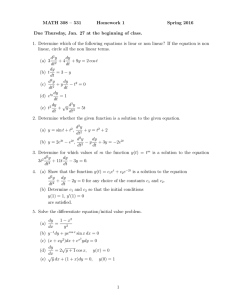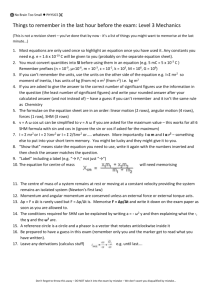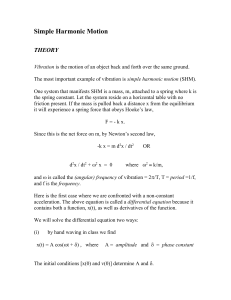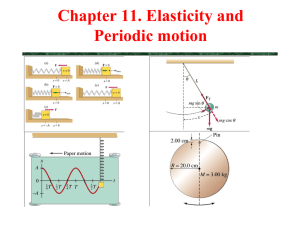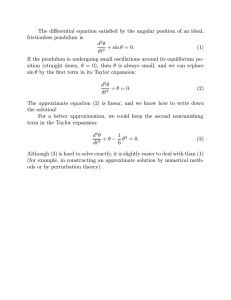The general solution is: x(t) A cos (ωt φ) SHM Solution
advertisement
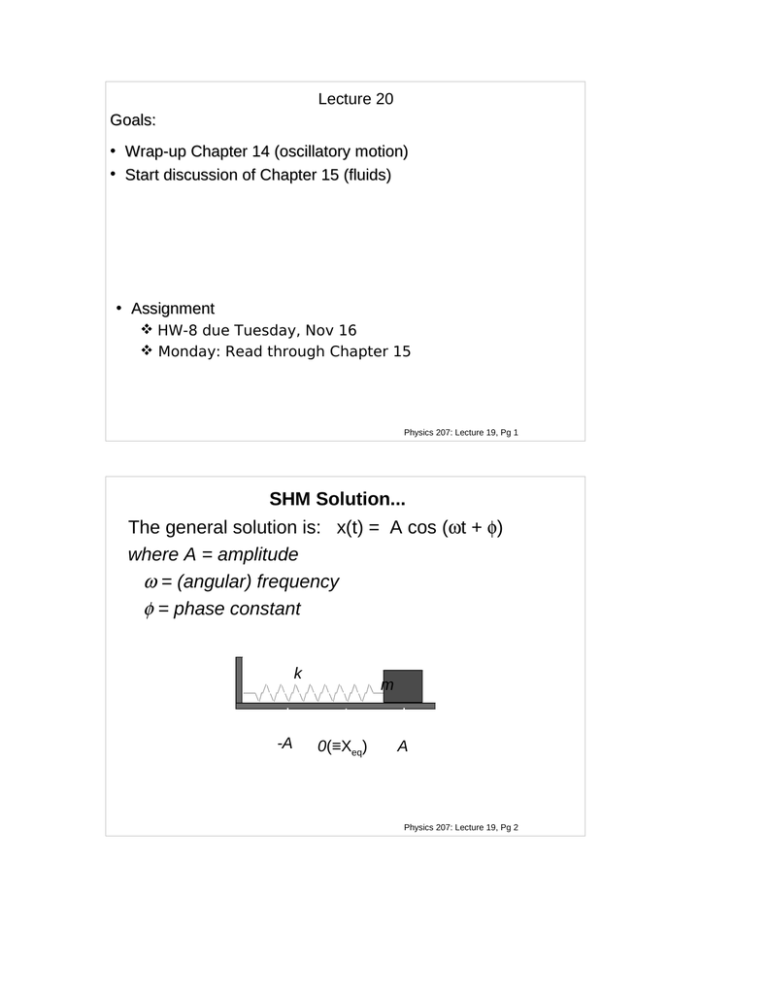
Lecture 20 Goals: Wrap-up Chapter 14 (oscillatory motion) Start discussion of Chapter 15 (fluids) Assignment HW-8 due Tuesday, Nov 16 Monday: Read through Chapter 15 Physics 207: Lecture 19, Pg 1 SHM Solution... The general solution is: x(t) = A cos (ωt + φ) where A = amplitude ω = (angular) frequency φ = phase constant k -A m 0(Xeq) A Physics 207: Lecture 19, Pg 2 SHM Solution... The mechanical energy is conserved: U = ½ k x2 = ½ k A2 cos2(ωt + φ) K = ½ m v2 = ½ k A2 sin2(ωt+φ) U+K = ½ k A2 E = ½ kA2 U~cos2 K~sin2 Physics 207: Lecture 19, Pg 3 k -A m 0(Xeq) A For simple harmonic motion, the kinetic energy of the mass is largest when: A)at x=A B)at x=-A C)at x=0 D)Neither of the above Physics 207: Lecture 19, Pg 4 k -A m 0(Xeq) k -1.5A T=1s A m 0(Xeq) 1.5A T is: A)T > 1 s B)T < 1 s C) T=1 s Physics 207: Lecture 19, Pg 5 SHM So Far For SHM without friction l The frequency does not depend on the amplitude ! lThe oscillation occurs around the equilibrium point where the force is zero! lMechanical Energy is constant, it transfers between potential and kinetic energies. Physics 207: Lecture 19, Pg 6 What about Vertical Springs? k k k equilibrium L m new equilibrium mg=k L Fnet= -k (y+ L)+mg=-ky L y=0 y m Fnet =-ky=ma=m d2y/dt2 Which has the solution y(t) = A cos( ωt + φ) Physics 207: Lecture 19, Pg 7 The Simple Pendulum l A pendulum is made by suspending a mass m at the end of a string of length L. Find the frequency of oscillation for small displacements. Σ Fy = may = T mg cos(θ) z Σ Fx = max = -mg sin(θ) If θ small then x ≅ L θ and sin(θ) ≅ θ dx/dt = L dθ/dt ax = d2x/dt2 = L d2θ/dt2 so ax = -g θ = L d2θ / dt2 and θ = θ0 cos(ωt + φ) with y θL x T m ω = (g/L)½ T = 2 (L/g)½ mg Physics 207: Lecture 19, Pg 8 Energy in SHM U = ½ k x2 U l The total energy (K + U) of a system undergoing SHM will always be constant! K E U -A 0 x A Physics 207: Lecture 19, Pg 9 SHM and quadratic potentials l SHM will occur whenever the potential is quadratic. l For small oscillations this will be true: l For example, the potential between H atoms in an H2 molecule looks something like this: U E U x K U -A 0 A Physics 207: Lecture 19, Pg 10 x What about friction? lOne way to include friction into the model is to assume velocity dependent drag. Fdrag= -bv=-b dx/dt Fnet=-kx-b dx/dt = m d2x/dt2 d2x/dt2=-(k/m)x (b/m) dx/dt a new differential equation for x(t) ! Physics 207: Lecture 19, Pg 11 Damped oscillations lFor small drag (under-damped) one gets: x(t) = A exp(-bt/2m) cos (ωt + φ) x(t) 1.2 1 0.8 0.6 0.4 A 0.2 0 -0.2 -0.4 -0.6 -0.8 -1 ωt t Physics 207: Lecture 19, Pg 12 Driven oscillations, resonance lSo far we have considered free oscillations. lOscillations can also be driven by an external force. oscillation amplitude ω0: natural frequency ωext ≅ ω0 ωext Physics 207: Lecture 19, Pg 13 Chapter 15, Fluids l An actual photo of an iceberg Physics 207: Lecture 19, Pg 14 l At ordinary temperature, matter exists in one of three states Solid - has a shape and forms a surface Liquid - has no shape but forms a surface Gas - has no shape and forms no surface l What do we mean by fluids? Fluids are substances that flow . substances that take the shape of the container Atoms and molecules are free to move. Physics 207: Lecture 19, Pg 15 Fluids lAn intrinsic parameter of a fluid Density (mass per unit volume) =m/V units : kg/m = 10-3 g/cm3 3 ρ(water) = 1.000 x 103 kg/m3 = 1.000 g/cm3 ρ(ice) = 0.917 x 103 kg/m3 = 0.917 g/cm3 ρ(air) = 1.29 kg/m3 = 1.29 x 10-3 g/cm3 ρ(Hg) = 13.6 x103 kg/m3 = 13.6 g/cm3 Physics 207: Lecture 19, Pg 16 Fluids lAnother parameter Pressure (force per unit area) P=F/A SI unit for pressure is 1 Pascal = 1 N/m2 lThe atmospheric pressure at sea-level is 1 atm = 1.013 x105 Pa = 1013 mbar = 760 Torr = 14.7 lb/ in2 (=PSI) Physics 207: Lecture 19, Pg 17 Pressure vs. Depth l For a uniform fluid in an open container pressure same at a y given depth independent of the container l Fluid level is the same everywhere in a connected container, assuming no surface forces p(y) l Why is this so? Why does the pressure below the surface depend only on depth if it is in equilibrium? F Imagine a tube that would connect two regions at the same depth. F If the pressures were different, fluid would flow in the tube! Physics 207: Lecture 19, Pg 18
